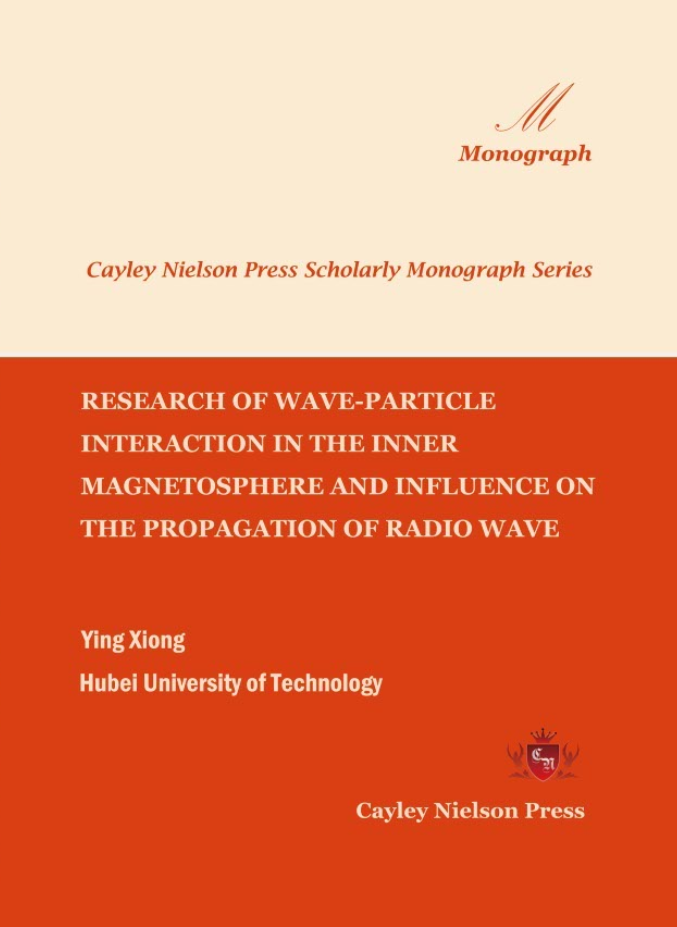
RESEARCH OF WAVE-PARTICLE INTERACTION IN THE INNER MAGNETOSPHERE AND INFLUENCE ON THE PROPAGATION OF RADIO WAVE

RESEARCH OF WAVE-PARTICLE INTERACTION IN THE INNER MAGNETOSPHERE AND INFLUENCE ON THE PROPAGATION OF RADIO WAVE
Author: Ying Xiong
Hubei University of Technology
Copyright © 2021 by Cayley Nielson Press, Inc.
ISBN: 978-1-7348822-9-2
Cayley Nielson Press Scholarly Monograph Series Book Code No.: 211-11-2
US$160.50
Preface
It is well known that a plasmaspheric drainage plume can be formed under the dynamic interaction between the convection electric field and corotation electric field. It can extend from the main plasmasphere in the dusk sector to the dayside magnetopause during geomagnetic storms. In the plasmaspheric plume, different energetic particles including ring current (RC), radiation belt and cold plasmasphere overlap each other so as to excite many kinds of plasma waves, such as electromagnetic ion cyclotron (EMIC) waves, ELF hiss. Because of the wave-particle interaction, energetic charged particles in inner magnetosphere precipitate into the low-altitude atmosphere protons, leading to decay of the RC and radiation belt. Therefore, the research on characteristics of wave-particle interaction in the plasmasphere and associated influences on the ionosphere is an important project in the coupling process between the inner magnetosphere and ionosphere. Though EMIC and hiss waves are known in the plasmaspheric plume, the spatial distribution of them is still an unresolved problem.
With observations of the ionosonde and co-located incoherent scatter radar at Millstone Hill in a storm-enhanced density (SED) plume identified from two-dimensional GPS TEC maps during a super geomagnetic storm, the SED plume can be transported from the mid- and low-latitude ionosphere to high-latitude ionosphere, which cause the global redistribution of plasma density in the ionosphere and magnetosphere. As a particle coupling bridge between the ionosphere and magnetosphere, the SED plume becomes a hot topic research. The SED plume is considered to a low-altitude signature of the plasmaspheric drainage plume. Due to the wave-particle interaction in the plasmasphere, energetic ions can precipitate into the ionosphere so as to change the electron density and have influence on the propagation of radio waves. Due to lacking of conjugated observations, few research has been done on the ionospheric effect of wave-particle interaction in the plasmaspheric plume
In order to reveal the characteristic of the wave-particle interaction and the influence on the ionosphere, the paper has studied the characteristic of the wave-particle interaction in the plasmaspheric plume, the physical mechanism of scattering of energetic ions into the loss cone and the influence of the wave-particle interaction in the plasmasphere on the ionosphere.
In summary, the main contents of this paper are mentioned as follows:
Chapter 1 covers the background knowledge of the research. In this chapter we introduce the associated basic theories, such as the structure and features of the magnetosphere, the plasmasphere and the ionosphere, including plasma waves, geomagnetic storms, magnetospheric substorms, and SED plumes etc.
Chapter 2 introduces the observational instruments and equipment used in the research.
Chapter 3 studies the characteristics of wave-particle interaction in the plasmaspheric plume with observations of multiple satellites and ground-based instruments during the geomagnetic storm on July 18, 2005. For the first time, the spatial distribution of the plasma waves in the plasmaspheric plume is revealed.
Chapter 4 focuses on the physical mechanism of scattering of energetic ions into the loss cone based on observations of the Cluster satellite on June 3, 2004 during its inbound passage from the plasma sheet into the inner magnetosphere.
Chapter 5 shows the influence of the wave-particle interaction in the plasmasphere on the ionosphere. With conjugated observations of satellite and ground-based instruments on 3 Mar. 2008, we show the effect of precipitation ions caused by EMIC waves on the ionospheric electron density and conductivity. In addition, with observations of the digisonde and co-located ISR at Millstone Hill in a SED plume from Nov 20 to 21, 2003, it is revealed that the feature of the height profile of the electron density and the influence of precipitation ions/electrons on the propagation of HF radio waves in the SED plume.
Chapter 6 summarizes the research work of this paper and the future research work is prospected.
Contents
Abstract..........................................................................................................................................................................................1
Preface..........................................................................................................................................................................................3
Chapter 1 Introduction of Magnetosphere and Ionosphere.............................................................................................6
1.1 Introduction of Magnetosphere......................................................................................................................................6
1.2 Structure of the Inner Magnetosphere ............................................................................................................................7
1.3 Plasma Wave..........................................................................................................................................................................9
1.4 Introduction of Ionosphere .................................................................................................................................................11
Chapter 2 Introduction of the Instruments ............................................................................................................................13
2.1 Cluster ....................................................................................................................................................................................13
2.2 POES..........................................................................................................................................................................................15
2.3 IMAGE....................................................................................................................................................................................17
2.4 Finnish Riometer Chain.......................................................................................................................................................19
2.5 GPS TEC....................................................................................................................................................................................21
2.6 ISR................................................................................................................................................................................................21
2.7 Digital Ionosonde........................................................................................................................................................................22
Chapter 3 Research of the Wave-particle Interaction in a Plasmaspheric Plume..................................................................24
3.1 Introduction..............................................................................................................................................................................24
3.2 Observations with Ground-based Instruments and Satellites....................................................................................27
3.2.1 Observations of EMIC and Hiss with Cluster..................................................................................................................30
3.2.2 Observations of Precipitation Particle with NOAA......................................................................................................42
3.2.3 Observations with the Finnish Riometer Chain............................................................................................................49
3.3 Analysis of the Characteristic of Wave-particle Interaction..........................................................................................50
3.4 Summary....................................................................................................................................................................................57
Chapter 4 Energetic Ions Scattered into the Loss Cone with Observations of the Cluster Satellite.................................60
4.1 Introduction................................................................................................................................................................................60
4.2 Observations of Wave and Particles with Satellite..............................................................................................................64
4.3 Analysis of Energetic Ions Scattering Mechanism..............................................................................................................71
4.4 Summary .....................................................................................................................................................................................78
Chapter 5 Ionospheric Characteristics Associated with Wave-particle Interactions during a Super Geomagnetic Storm..80
5.1 Introduction.................................................................................................................................................................................80
5.2 Analysis of the Event ..................................................................................................................................................................84
5.2.1 Influence of Precipitating Energetic Ions on the Ionospheric E-region Caused by EMIC Waves...........................85
5.2.1.1 Observations.......................................................................................................................................................................86
5.2.1.2 Discussion and Conclusion...............................................................................................................................................92
5.2.2 Ionospheric Characteristics Associated with Wave-particle Interactions in a SED Plume during a Super Geomagnetic Storm.100
5.2.2.1 Observations....................................................................................................................................................................101
5.2.2.2 Discussions and Conclusion..........................................................................................................................................106
5.3 Summary.................................................................................................................................................................................112
Chapter 6 Conclusions and Prospect......................................................................................................................................115
6.1 Conclusions............................................................................................................................................................................115
6.2 Prospect................................................................................................................................................................................117
References..................................................................................................................................................................................119
Readership
This book should be useful for students, scientists, engineers and professionals working in the areas of optoelectronic packaging, photonic devices, semiconductor technology, materials science, polymer science, electrical and electronics engineering. This book could be used for one semester course on adhesives for photonics packaging designed for both undergraduate and graduate engineering students.
